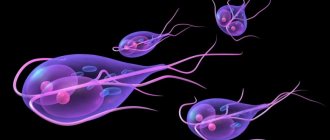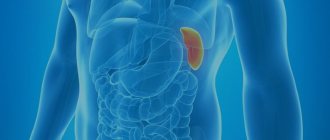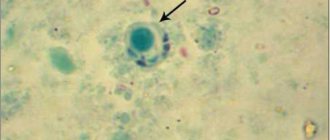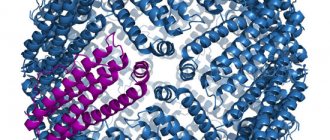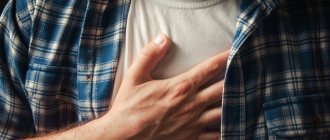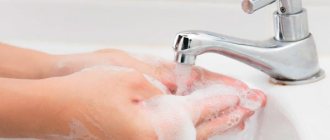Published: 10/26/2021 15:20:00 Updated: 10/26/2021
Giardiasis is a protozoal infection caused by the protozoan Giardia, which affects the small intestine. Manifested by indigestion. This infectious agent was first described by the Czech doctor D. F. Lambal in 1859. Not only the parasite, but also the disease was later named after him.
According to WHO, about 200 million people worldwide are infected with Giardia every year. Most often this happens in the countries of Asia, Africa, and Latin America. According to official data, up to 150 thousand infections with these protozoa are detected in Russia every year.
Giardiasis is often the cause of intestinal disorders in children of preschool and primary school age. In adults it is mostly asymptomatic.
Causes
Giardia is the simplest microscopic unicellular parasite from the class of flagellates.
In the human intestine it can be in two forms - vegetative and spore. Giardia reproduces by division and doubles in number every 10-12 hours. The habitat of vegetative forms is the upper section of the small intestine. Cysts are immobile, oval in shape and protected by a capsule. In this form, Giardia exists in the colon, as well as in the external environment. This way they can remain viable for a long time. The main causes of giardiasis are the entry of cysts into the human body. This happens when eating unwashed vegetables and fruits, violating hygiene rules, and using unboiled water. This route of transmission is called fecal-oral, since the source of the spread of giardiasis pathogens is an infected person who excretes cysts along with feces. Pets can also be carriers of giardiasis, and flies and cockroaches act as carriers.
Provoking factors can be overcrowding, living in a polluted environment, poor condition of water supply and sewerage systems, and non-compliance with sanitary and hygienic rules. A predisposition to the disease has been identified in children under the age of 10 years, in people with malnutrition or dystrophy, congenital defects of the biliary tract, diseases of the stomach and intestines with a reduced level of acidity, as well as in those adhering to diets with too low a protein content.
Additional drug therapy
To influence pathogenic intestinal microflora, Enterol (1-2 capsules or a packet of powder 2 times a day for a week) or Intetrix (4 capsules per day for four days) is usually prescribed. To combat dysbiosis, probiotics are used (Narine, Linex, Bio-Gaia, Bifiform, etc.). For liver damage, hepatoprotectors (Gepabene, Karsil) and choleretic agents (Allohol) are indicated. Also, to improve the functioning of the gallbladder, you can use drugs such as Hofitol or Holosas. By the way, these drugs slightly increase urination, which promotes the rapid elimination of toxins.
If the results of the coprogram indicate an enzymatic deficiency, then Mezim, Festal, Creon or Pancreatin are prescribed. Even in the absence of clinical symptoms of an allergic reaction, antihistamines are necessary. These are Erius, Claritin, Telfast, Cetrin. 1 – 2 tablets per day is enough. Sometimes you may feel drowsy after using these medications. That is why it is recommended to take them in the afternoon before bed.
Acute and chronic giardiasis most often occurs in people with weakened immune systems. Therefore, after the end of antiparasitic therapy, it is necessary to identify the cause of disturbances in the functioning of the immune system. In some cases, additional drug support with immunomodulators (Polyoxidonium, Lykopid) is necessary.
Classification
Signs of giardiasis may not be noticeable in a quarter of all cases.
This condition is called asymptomatic carriage. In this case, the person himself is not sick, but he becomes a source of infection for others. In half of all patients with giardiasis, the disease is subclinical. They also have no symptoms and do not consider themselves infected. Only diagnostics can help identify the disease.
And only in the remaining percentage of patients the disease has pronounced symptoms, which can be acute, subacute or chronic.
Common myths about infection
Many people do not even suspect that they are mistaken about the ways in which parasites enter the body, while remaining disarmed in the face of a serious parasitic infection.
After stroking a cat or dog, infection occurs in 90% of cases
Even if a person strokes a yard cat or a stray dog, this does not mean that infection will occur. The fact is that the bacteria of our smaller friends are somewhat different from the bacteria that inhabit the human body. Those Giardia, which in theory can be found on a cat's fur, in practice die in the human digestive tract, since saliva and gastric juice are an aggressive environment that leads to the death of a large number of pathogenic microorganisms.
If a person washes their hands thoroughly after contact with an animal, the likelihood of infection is minimal. The same applies to the fact that to colonize the intestines, at least 10-25 cysts must enter the body. Single individuals, even if they penetrate the body, will be eliminated by their own protective forces of the immune system.
Cat scratch causes infection
Giardia is not able to enter the body through the blood. The acid-alkaline environment is destructive for parasites, so no scratches can provoke the development of giardiasis. But this does not mean that scratches and cuts do not need to be disinfected. There are a lot of other bacteria that can enter the local and general bloodstream, causing diseases that are more dangerous than giardiasis.
Giardia is transmitted by kissing from a sick person to a healthy one.
This is impossible for the simple reason that saliva is an aggressive environment for parasitic cells, which makes them non-viable. Even if a person is infected, Giardia cannot be transmitted through a kiss, but if you live together with an infected person, the risk of spreading the disease remains if the rules of personal hygiene are not followed.
Giardiasis - brought from the sea
It is impossible to catch Giardia in sea water, since even small concentrations of salt in the water have a detrimental effect on the condition of the parasites. Accordingly, sea water cannot be a habitat for Giardia. But in sand or soil, especially on city beaches, where hygiene standards are not followed, there is every chance of getting giardiasis if you forget about washing your hands and food.
Giardia can be transmitted through unclean sand
As for reservoirs with stagnant water, at the highest possible temperatures in the summer months, you should avoid them and under no circumstances swim, since fresh water is infested with Giardia.
Pets, as well as people, are at risk of contracting giardiasis. By the way, they suffer from this infection much more often than their owners, but they are not always diagnosed and treated. This is how a furry family member becomes a carrier of a dangerous disease.
Symptoms
Giardiasis often has mild symptoms and occurs without pronounced clinical manifestations.
In the typical form of the disease, the first symptoms begin to appear after the end of the incubation period, which lasts from 1 to 3 weeks, and during this time the disease has no manifestations. The intestinal form of the acute stage is characterized by:
- Pain in the right hypochondrium, in the navel area and rarely in the lower abdomen.
- Belching.
- Feeling of heaviness in the left side of the abdomen.
- Decreased appetite.
- Frequent bowel movements up to 3-5 times a day, which can give way to constipation.
- Nausea.
- Constant feeling of heaviness in the stomach.
- Flatulence.
In young children, mushy stools are observed.
The duration of the acute phase of the disease is 5-7 days, after which either recovery occurs or the infection transitions to a subacute chronic course. The hepatobiliary variant of giardiasis in women and men is manifested by pain in the liver area and indigestion.
Skin manifestations can be very different and include pallor, the appearance of a icteric tint, dryness and flaking, and a small allergic rash. Stomatitis may develop in the mouth, and jams or cracks may appear in the corners of the mouth.
The intoxication syndrome during giardiasis depends on how many cysts enter the body, as well as on the duration and severity of the disease. Patients may complain of headaches, dizziness, sleep disturbances, decreased performance, irritability, and emotional lability. Children may experience tics, hyperkinesis, and fainting.
What are Giardia?
The name Giardia is an unofficial name. So people named them in honor of the Czech anatomist Lamblius Vilem Dusan, who discovered them in 1859. Giardia or giardia is the name adopted in medicine.
They belong to a very common order of protozoa - diplomonods. Giardia is quite small in microscopic size and cannot be seen without a microscope. Under the device we will be able to see small teardrop-shaped creatures. They have four pairs of tourniquets, with a suction disk, with the help of which they are attached to the intestines. These are not worms, because they are single-celled. In fact, it is between bacteria and multicellular organisms.
Anthony van Leeuwenhoek, the scientist who first tested the microscope, discovered Giardia, and further research was continued in the 19th century. Soviet pediatricians paid close attention to these tiny parasites; they considered them the main culprits of most intestinal disorders in children.
Diagnostics
Testing for giardiasis is the only reliable way to identify the disease, since it often occurs without symptoms and has no specific manifestations.
The main list of tests for diagnosing giardiasis includes:
- Antigenic test for Giardia, to detect them in feces using ICA (immunochromatographic). Helps identify acute or chronic forms of giardiasis, asymptomatic carriers, and is also an effective method for evaluating treatment.
- Determination of antibodies of classes A, M, G (IgM, IgA, IgG) to Giardia in the blood using ELISA (enzyme-linked immunosorbent assay) for timely detection of infection.
- Express examination of stool for antigens to Giardia, amoebae, and cryptosporidium, which helps to diagnose parasitic diseases that occur without obvious symptoms.
- Microscopic method for examining stool for protozoa and helminth eggs.
- Fecal analysis for carbohydrates, which is prescribed for diseases of the small intestine with suspected Giardia infection.
All other tests and studies for giardiasis are considered nonspecific and are prescribed according to indications. These may be blood tests, urine tests, gastroscopy or ultrasound of the abdominal organs.
Possible complications
Any complications are associated with an increase in symptoms that appear as the disease develops. These are allergies, intestinal dysfunction, cholecystitis, pancreatitis, and disorders in other systems.
An advanced disease can lead to diagnostic errors. This happens in cases where a developed complication is taken as the root cause of a poor condition.
Treatment
Giardiasis requires complex treatment.
Therapy for uncomplicated forms is carried out on an outpatient basis. When the diagnosis is confirmed, one of the antigiardiasis drugs is prescribed, which must be combined with the use of choleretic drugs, as well as drugs that improve intestinal microflora. The chronic course requires long-term complex treatment, which will include not only medication, but also a diet for giardiasis, which limits the intake of carbohydrates into the body. Etiotropic drugs help to cope with protozoa, and immunotherapy helps to increase a person’s natural defenses. Choleretic agents and probiotics must be prescribed to restore intestinal microflora.
Modern medicine in the treatment of giardiasis offers some clinical recommendations. At the first stage, diet therapy and fasting days are prescribed, as well as taking choleretic and, if necessary, antihistamines.
At the second stage, the patient takes special antiprotozoal drugs prescribed by the doctor. To get rid of Giardia, not one, but two courses are often prescribed.
At the third stage, multivitamins, enterosorbents, enzyme preparations, immunostimulants, and herbal medicine are used.
Folk recipes
We bring to your attention several common recipes for traditional treatment of giardiasis that help remove giardia from the body:
- prepare a decoction of burnet (6 grams of herb per glass of water, boil for 10 minutes), which is taken once a day before meals. Dosage – 100 ml;
- 100 ml of beet juice are mixed in equal proportions with carrot juice, cognac and honey. The mixture is thoroughly mixed and taken three times a day half an hour before meals;
- Take green walnuts, cut them into several pieces and pour in 1 liter of vodka. The tincture reaches its condition in a dry, dark place within two weeks. The medicine is taken three times a day, one teaspoon.
Prevention
After recovery, the risk of re-infection does not decrease, and relapses occur frequently.
To completely get rid of parasites, repeated doses of medication are often required. Dispensary observation is carried out for 3-6 months with mandatory examination for parasites. To prevent infection with giardiasis, you should not drink raw water, even from the tap, follow all sanitary and hygienic rules, be sure to wash your hands before eating and after using the toilet, and do not eat unwashed vegetables, fruits, and berries.
It is important to consult a doctor at the first suspicion of a disease and undergo all the necessary tests to refute or confirm the diagnosis with further mandatory treatment.
Author:
Pugonina Tatyana Alekseevna, Therapist
How does Giardia infection occur?
Giardia infection can occur directly through the fecal-oral route or indirectly through ingestion of contaminated water or food. Water contaminated with Giardia cysts appears to be the main reservoir and means of spread of the parasite. Most outbreaks of waterborne giardiasis have been associated with the consumption of untreated or improperly treated surface water. Transmission of giardiasis from person to person often occurs in child care institutions and in families where there are children with diarrhea. Human immune defense is dependent on B cells, with secretory immunoglobulin A playing a major role in immunity. Children with humoral immunodeficiencies, such as X-linked agammaglobulinemia and hypogammaglobulinemia, who develop giardiasis are predisposed to chronic disease.
G. duodenalis infection is more common in certain high-risk groups, including children, staff and visitors of child care facilities, patients and staff of institutions for people with developmental disabilities, people who drink contaminated drinking water or water from lakes, rivers or insufficiently treated swimming pools, travelers to endemic areas of the world, close contacts of people with Giardia, people taking antibiotics, and people in contact with domestic and wild animals (eg dogs, cats, cattle, deer and beavers).
What should be the diet for giardiasis?
Nutrition should solve the following problems:
- Deprive parasites of a nutrient medium;
- Cleanse the body of toxins released by lamblia.
The following are completely excluded from the diet:
- Sweet and bakery products, chocolate, sugar, honey and baked goods;
- Spicy, smoked, pickled and fatty foods;
- Sausages and pasta;
- Sweet fruits, including melons, bananas, sweet grapes;
- Carbonated sweet juices, alcohol, dairy drinks;
- Radish, onion, horseradish, radish and garlic.
The diet for lambiasis should include the following products:
- Lean fish and meat;
- Hateful soups and broths;
- Porridges on water: corn, rice, oatmeal, buckwheat and barley;
- Rice water;
- Unsweetened cottage cheese and yogurt, feta cheese;
- Vegetables: tomatoes, zucchini, carrots and cucumbers (boiled, stewed, raw);
- Sour berries and fruits, fruit drinks, juices and compotes from them: currants, cranberries, blackberries, sour apples and citrus fruits.
